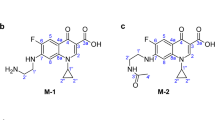Summary
The absence of a lag period in the bioconversion of chloramphenicol by spores and the pronounced influence of the pH of the medium on this reaction strongly suggested that chloramphenicol acetyltransferase (CAT) is located at or near the surface of the spores of Streptomyces griseus. A two-hour exposure of spores to dilute solutions of β-mercaptoethanol or surfactants resulted in significant decrease in activity even in the presence of glucose as an energy source. However, the inclusion of any of the reagents in the reaction mixture neither influenced the conversion activity nor the spore viability. These treatments did not reveal any cryptic activity for CAT in the spores. In addition, more drastic treatment of the spores with ethylenediaminetetraacetate (EDTA) or with concentrated salt solutions did not reduce the activity nor significantly affect the spore viability. Considering the modes of action of β-mercaptoethanol and the surfactants, a combination of disulfide bridges and lipoprotein interactions may be responsible for the binding of CAT to the surface of the spore. Moreover, results of acid treatment of intact spores indicated that most of CAT activity, if not all, is located at the spore surface. Incorporation of 14C-acetate by cell-free extracts of Streptomyces griseus clearly showed that CAT selectively catalyzed the formation of chloramphenicol-3-acetate at an optimum pH of 6.5. The shape of the pH-activity curve in cell-free extracts is essentially identical to that of the enzyme in intact spores and is additional evidence that the enzyme is located at the spore surface.
Similar content being viewed by others
References
Barash I, Klein L (1969) Surface localization of polygalacturonase in spores of Geotrichum candidum. Phytopathology 59:319–324
Bibb MJ, Ward JM, Hopwood DA (1978) Transformation of plasmid DNA into Streptomyces at high frequency. Nature 274:398–400
Eberhart BM, Beck RS (1970) Localization of the β-glucosidases in Neurospora crassa. J Bacteriol 101:408–417
EL-Kersh TA (1976) Biotransformation of chloramphenicol by spores of Streptomyces griseus. Ph D Thesis, Univ de Montréal, Montréal, Québec, Canada
EL-Kersh TA, Plourde JR (1976a) Biotransformation of antibiotics I. Acylation of chloramphenicol by spores of Streptomyces griseus isolated from Egyptian soil. J Antibiot 29:292–302
EL-Kersh TA, Plourde JR (1976b) Biotransformation of antibiotics II. Investigation of the chloramphenicol acetyltransferase in Streptomyces griseus. J Antibiot 29:1189–1198
EL-Kersh TA, Plourde JR (1976c) Microbiol transformation of antibiotics VI. Specificity of chloramphenicol acetyltransferase (CAT) in spores of Streptomyces griseus. In: Proc 19th Annu Meet Can Fed Biol Soc 15–18 June, Dalhousie Univ, Halifax, Paper 528
Gaffney DF, Foster TJ, Shas WV (1978) Chloramphenicol acetyltransferase determined by R plasmids from gram-negative bacteria. J Gen Microbiol 109:351–358
Lisker N, Katan J, Chet I, Henis Y (1975) Release of cell-bound polygalacturonase and cellulase from mycelium of Rhizoctonia solani. Can J Microbiol 21:521–526
Mandels GR (1953) The properties and surface location of an enzyme oxidizing ascorbic acid in fungus spores. Arch Biochem Biophys 42:164–173
Mandels GR, Vitols R (1967) Constitutive and induced trehalose: Transport mechanisms in spores of the fungus Myrothecium verrucaria. J Bacteriol 93:159–167
Marziuf GA (1973) Regeneration of invertase in Neurospora crassa. J Bacteriol 115:146–152
Metzenberg RL (1963) The localization of β-fructofuranosidase in Neurosopra crassa. Biochim Biophys Acta 77:455–465
Neu HC (1968) The surface localization of penicillinases in Escherichia coli and Salmonella typhimurium. Biochem Biophys Res Commun 32:258–263
Ogawara H (1975) Production and property of β-lactamases in Streptomyces. Antimicrob Agents Chemother 8:402–408
Plourde R, Hafez-Zedan H (1973) Distribution of steroid 1-dehydrogenation and side chain degradation enzymes in spores of Fusarium solani: Causes of metabolic lag and carbohydrate independance. Appl Microbiol 25:650–658
Pollock MR (1971) The function and evolution of penicillinase. Proc R Soc London Biol Sci 179:385–401
Santos T, Sanchez M, Villanueva JR, Nombela C (1979) Derepression of β-1, 3-glucanase in Penicillium italicum: Localization of the various enzymes and correlation with cell wall glucan mobilization and autolysis. J Bacteriol 137:6–12
Schrempf, H, Bujard H, Hopwood DA, Goebel W (1975) Isolation of covalently circular deoxyribonucleic acid from Streptomyces coelicolor A3 (2). J Bacteriol 121:416–421
Scott WA, Metzenberg RL (1970) Location of aryl sulfatase in conidia and young mycelia of Neurospora crassa. J Bacteriol 104:1254–1265
Shaw WV (1971) Comparative enzymology of chloramphenicol resistance. Ann NY Acad Sci 182:234–242
Shaw WV (1975) Chloramphenicol acetyltransferase from chloramphenicol resistant bacteria. In: Colowick SP, Kaplan NO (eds) Methods in enzymology, vol 43. Acad Press Inc, New York, pp 737–755
Sinohara H (1972) Induction of enzymes in dormant spores of Aspergillus oryzae III. Effects of kanamycin and streptomycin. Biochim Biophys Acta 281:425–433
Suzuki Y, Okamoto S (1967) The enzymatic acetylation of chloramphenicol by multiple drug resistant Escherichia coli carrying R factor. J Biol Chem 242:4722–4730
Vernon LP, Mangum TH (1960) Cytochromes of Bacillus megaterium and Bacillus subtilis. Arch Biochem Biophys 90:103–110
Weimberg R, Orton WL (1965) Elution of acid phosphatase from cell surface of Saccharomyces mellis: J Bacteriol 90:82–94
Wood DAW, Tristram H (1970) Localization in cell and extraction of alkaline phosphatase from Bacillus subtilis. J Bacteriol 104:1045–1051
Yagisawa M, Huang TSR, Davies JE (1978) Possible involvement of plasmids in biosynthesis of neomycin. J. Antibiot 31:809–813
Zalokar M, Cochrane VW (1956) Diphosphopyridine nucleotidase in the life cycle of Neurospora crassa. Am J Bot 43:107–110
Author information
Authors and Affiliations
Rights and permissions
About this article
Cite this article
El-Kersh, T.A., Plourde, J.R. Biotransformation of antibiotics. European J. Appl. Microbiol. Biotechnol. 10, 317–326 (1980). https://doi.org/10.1007/BF00498728
Received:
Issue Date:
DOI: https://doi.org/10.1007/BF00498728




